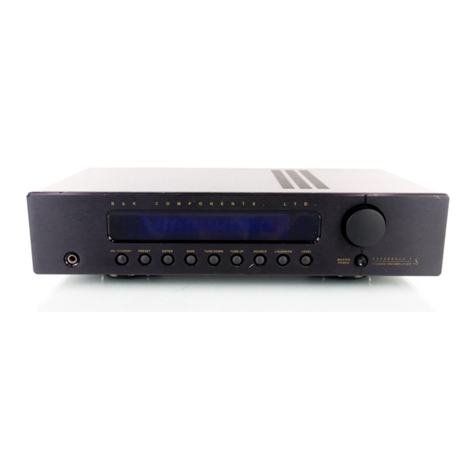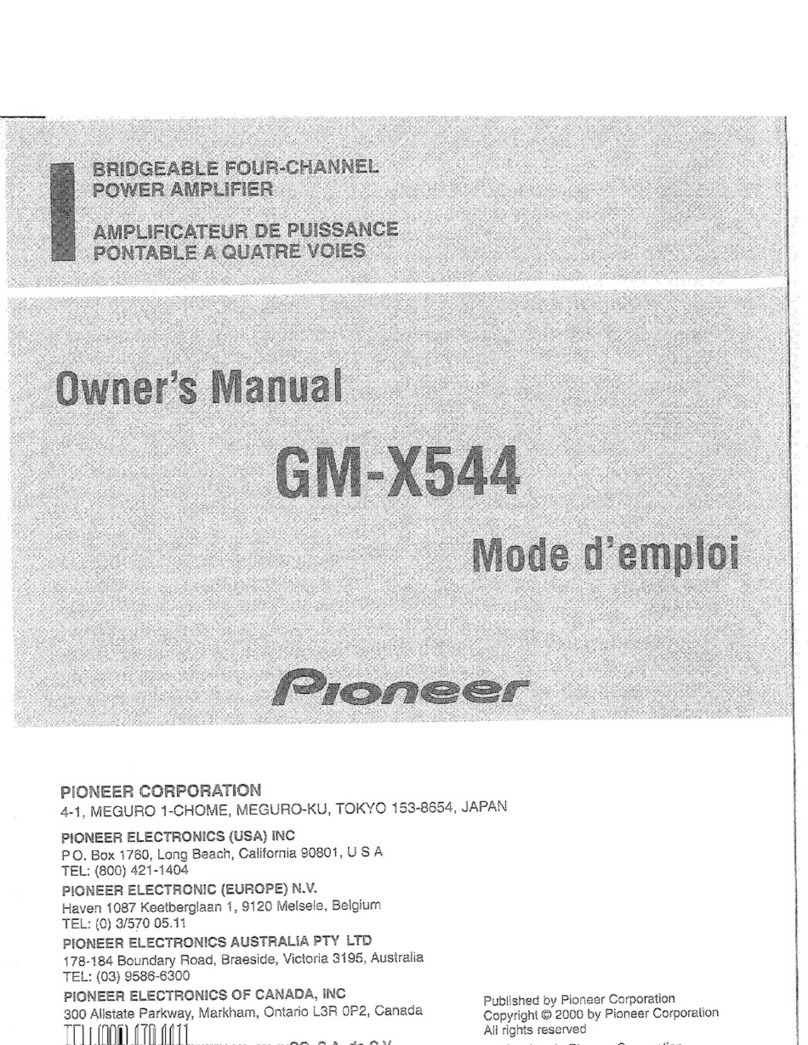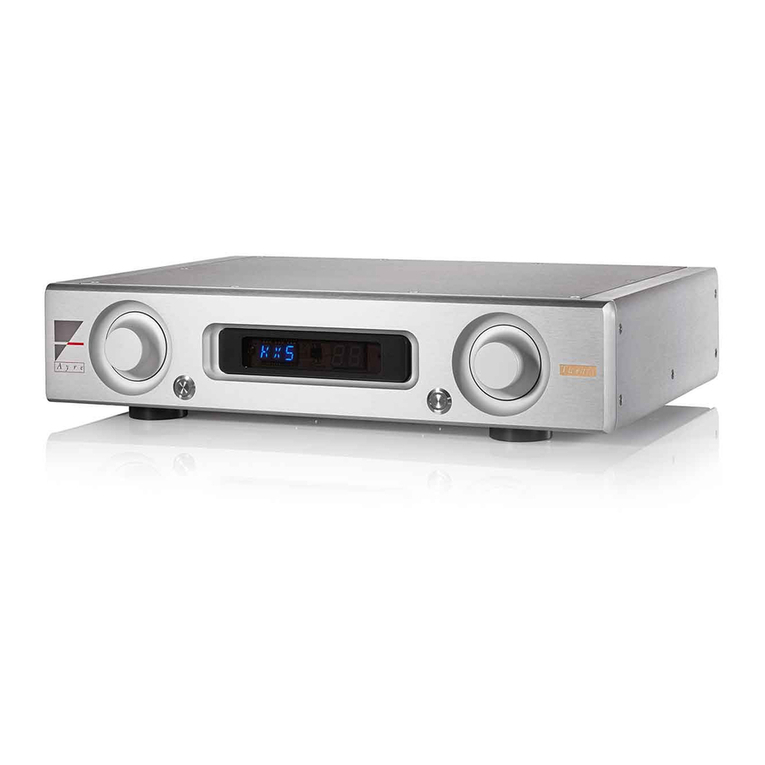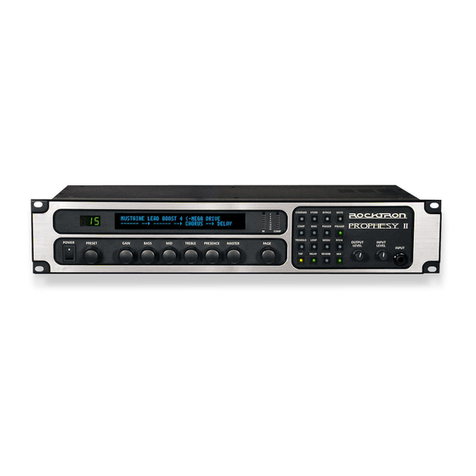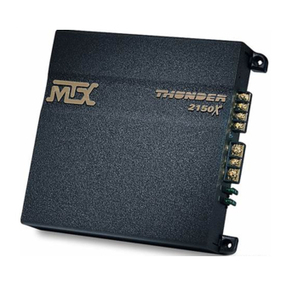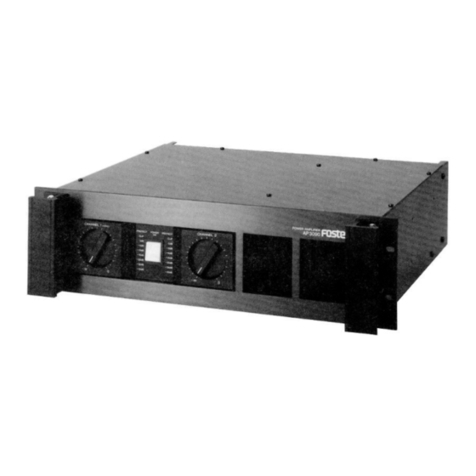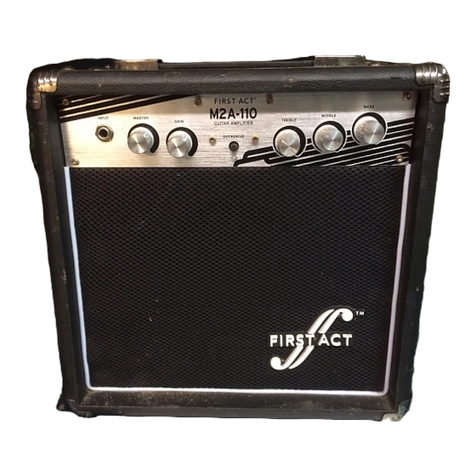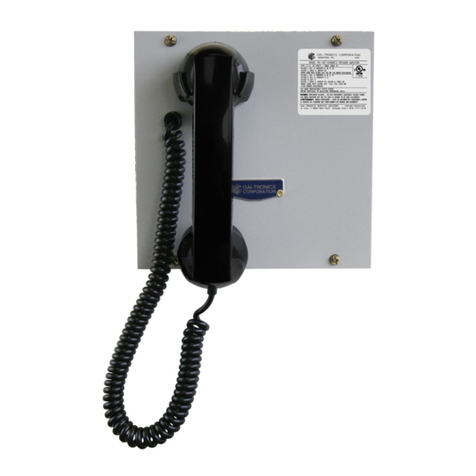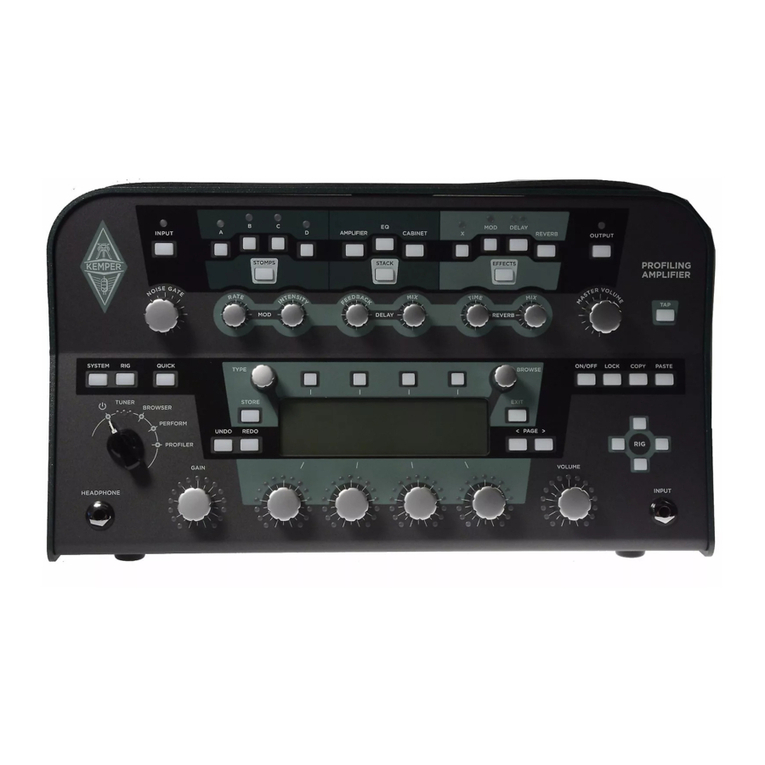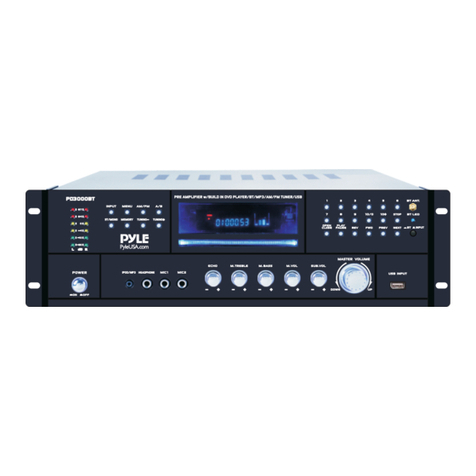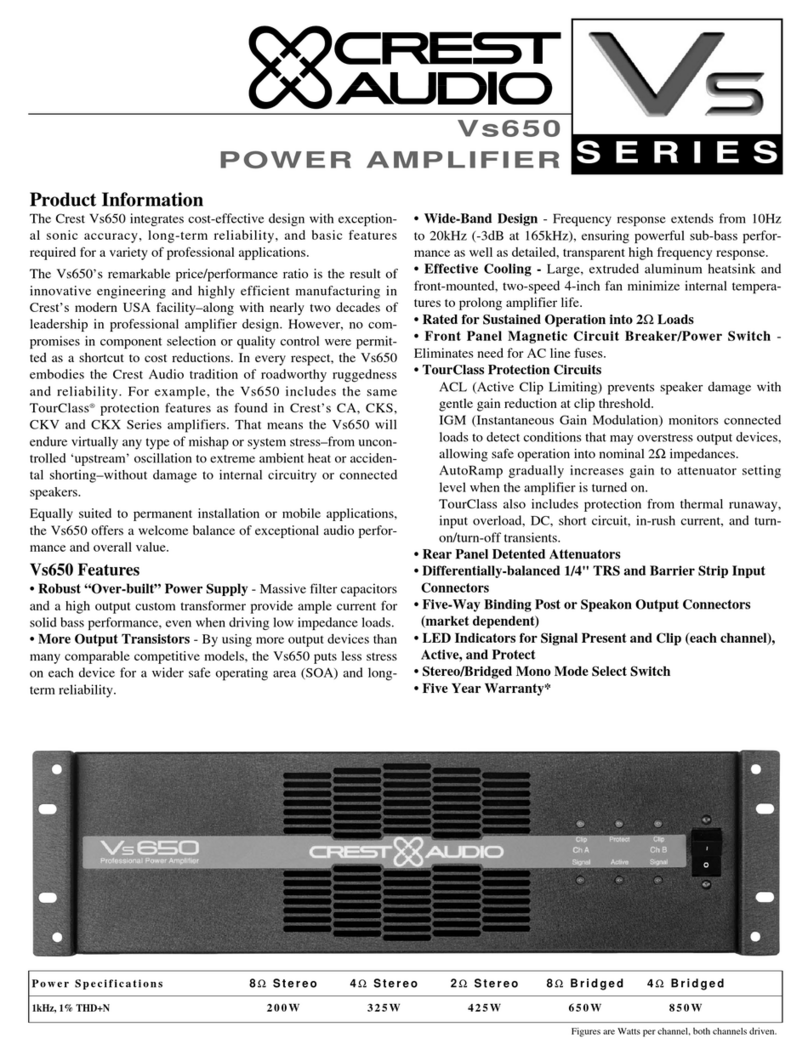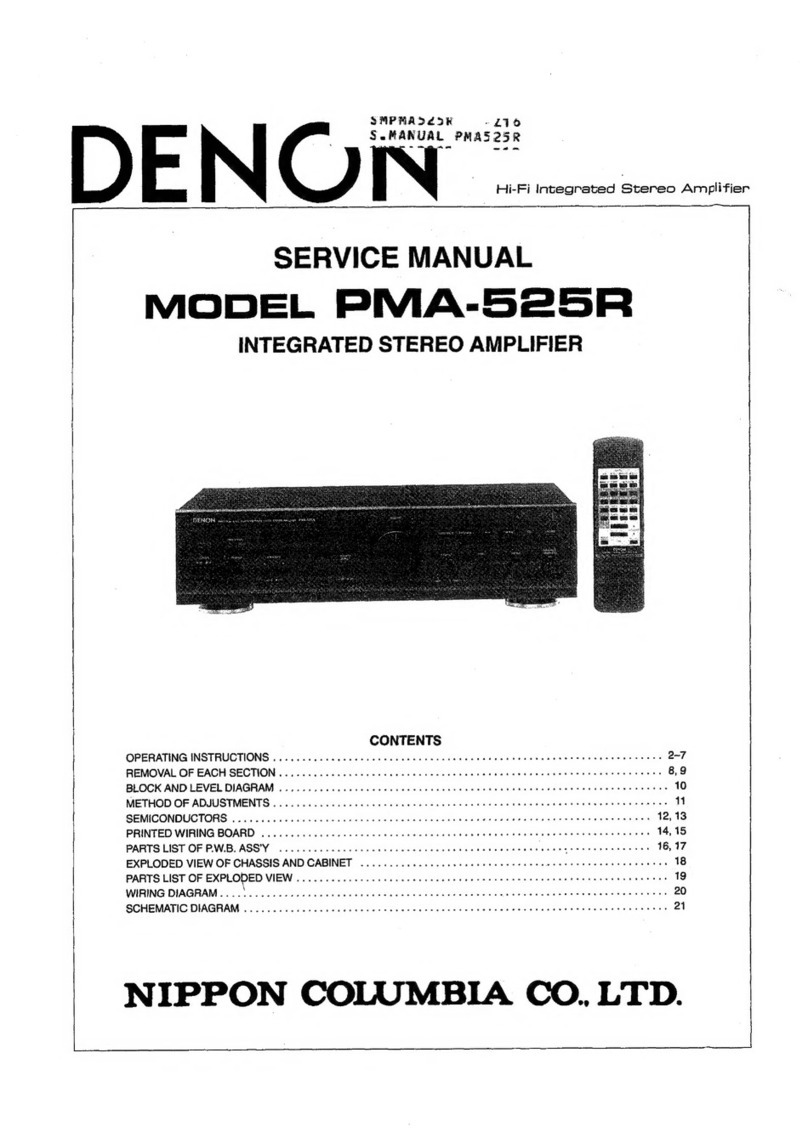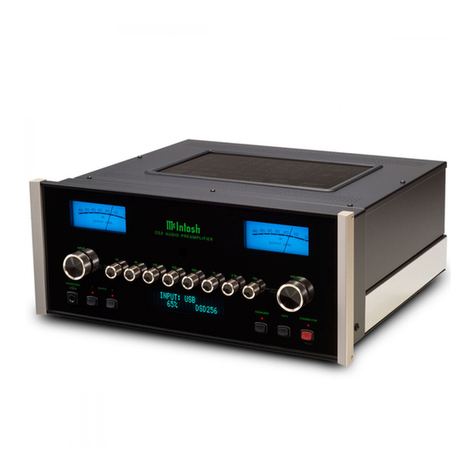TRU Audio A75 User manual

User Manual
A75
12 Channel - Power Amplifier
TRUAUDIO’s 12-channel power amplifier is a
perfect solution for those multi-room audio
installations that require flexibility and quality sound.
With it’s smooth appearance and versatility, this
well-constructed amplifier has many features to
enhance your installation and can be customized to
fit any system.
Features include: individual input sensitivity control
for each channel, line input for each channel and
BUS 1 and BUS 2 source inputs and outputs,
bridging between channels, in and out triggers, with
a ground lift circuit. The specially designed digital
chip set will minimize unwanted heat build-up to
ensure the high quality audio reproduction and
longevity of the amplifier.
Never expose the amplifier to any kind of moisture.
This piece should NOT be used near bath tubs,
sinks,wet basements or swimming pools. Also avoid
placing this unit by heat sources such as radiators,
heat registers or stoves.
This unit should not be in direct sunlight.
Before connecting any cables to the amplifier, the
power must be OFF.
When deciding on where to place the unit, make
sure there is plenty of airflow. Do not set other
components directly on top of the amplifier. If other
components must be placed on top of this piece,
you must use some kind of spacers. If it will be
installed into a cabinet, the cabinet should have
proper airflow, adding an additional cooling fan
might be necessary.
Make sure the speakers that will be connected to
this unit can handle the output power of the
amplifier.
We suggest NOT to use any kind of extension cord
unless it is polarized and made from heavy gauge
wire. If at all possible, plug this unit directly into the
wall outlet or surge protection.
Front Panel:
Power Switch:
This is used to turn the unit on or off.
LED Indicators:
There is one LED indicator for the power and each
zone.
NOTE: If a fault occurs within a particular zone, the
LED changes to RED. If the fault remains, the
corresponding LED remains red and you must
power cycle off and on to clear the fault. If the fault
is momentary, then the zone LED changes to red
and then switches to solid blue after a few seconds.
Once all zones are cleared of faults the front LED’s
will turn blue as long as they are active.
Rear Panel:
On/Auto/Trigger Switch:
ON MODE
All zone LED lights will be off until an audio signal is
introduced to the BUS or LINE-IN inputs. When
audio signal is present, appropriate zone lights will
turn blue to indicate zone or zones are on. After 8
seconds without an audio signal the zone or zones
will turn off. Zone LED lights will remain off until
each zone senses an audio source to the zone
input.
AUTO MODE
The inputs on the amplifier will detect an audio
source and turn on when a source is present; after
Caution:
MAKE SURE TO READ THIS INSTRUCTION
MANUAL BEFORE TURNING THE POWER ON
OR HOOKING UP THIS POWER AMPLIFIER.
Description
General Information & Features

approximately 20 minutes without an audio source
the amplifier will go into standby mode. After
entering sleep mode there will be a 10 second
power cycle period from sleep mode to play an
audio signal.
TRIGGER MODE
The amplifier will only turn on and off when using
the 12v input and/or output. There will be a 10
second power cycle period from time power is
applied to the trigger to play an audio signal.
For general use it is recommended the amplifier be
left in the "ON" position.
NOTE: The amplifier has a 10 second power cycle
period before it will play an audio signal if either the
Auto or Trigger are selected. This is normal and
required to comply with the EU < .5 WATT ERP
directive.
BUS 1 & 2 Inputs:
There are “right” and “left” RCA style connectors
labeled as “1” & “2”. These inputs are used for
sending a single audio source (i.e. CD, Tuner, MP3
etc.) to more than one zone. For using this feature
correctly, see “Connecting the Amplifier” later in this
manual.
BUS 1 & 2 Outputs:
There are “right” and “left” labeled as “1” & “2”.
These outputs are used to loop the audio source
that is connected to the “BUS INPUTS” out to a
second A75.
Individual Zone Line Inputs:
These RCA style input connectors are the audio
inputs for each individual channel of the amplifier.
These inputs are to have audio sources dedicated to
a single channel or zone on the amplifier. We
suggest using a good quality RCA patch cable for
best performance. The RCA inputs are labeled
“Left” and “Right”.
ST/BR Switch:
This is used to switch each individual zone between
stereo, or bridged.
BUS/LINE IN Switch:
This is used to indicate which input the individual
channel or BUS will receive audio source from.
Gain Adjustment:
This is an adjustment for the different voltage inputs
with each source (75mVrms-3Vrms). Set the control
so that the speakers are not distorting.
Ground Lift Switch :
If there is a problem with 60Hz ground loop with this
amplifier, with this switch you can switch it to
“Grounded” or “Isolated”.
Speaker Terminals:
These Phoenix type terminal connectors are used to
connect the speaker to each zone.
3-Conductor AC Cord Receptacle w/fuse:
A standard male receptacle that fits a 3-conductor
power cord.
Connecting the Amplifier
Always turn off the power of your amplifier,
processor/preamp and all input/playback units
before any connections are made. Before turning
your amplifier and preamp back on, make sure your
source volume is turned all the way down.
Remember the cooling issues mentioned earlier in
this manual. Improper airflow will reduce the life of
the amplifier.
When deciding on the final location, keep in mind
that there needs to be adequate space behind the
amp to fit the speaker cables and patch cables.
Stereo Connection:
Use a good quality RCA type patch cord. Connect a
stereo RCA cable from your audio source to one of
the inputs (Bus 1 & 2 or line-in) on the back of the
amplifier. Repeat this for each channel and/or zone
if using the line-in inputs.
The ST/BR switch should be in the “Stereo” posi-
tion. Connect the speaker cable coming from each
pair of speakers to the “Speaker Input” connector
on the back of the amplifier. This connector is
removable to make connection easier. When
connecting the cable to the connector, check for
any wire strands that might be sticking out of the
connection terminalthat might cause a short.
These amplifiers are stable down to 4 ohms. The
impedance with the connected speakers should not
be lower than 4 ohms.

Specifications
Bridged Connection:
The bridging mode is meant for a single speaker
and high power application such as Home Theater.
In the bridged mode the speakers should be 8 ohm
minimum.
Make sure the amplifier power is OFF before making
connections.
Connect the right and left outputs from the audio
source to the left input of the zone you are bridging.
Repeat this for each zone you want in bridged
mode.
The “ST/BR” switch should be in the bridged (BR)
position. Make sure the switch is in this mode only
on the zones you want bridged.
Connect the speaker cables coming from one
speaker to the “speaker input” connector on the
back of the amplifier. For bridging, one speaker will
connect to one connector. Make sure to follow the
labeling on the back of the amp where the speaker
input connector is for the bridged zone. The speaker
input connector is removable to make connection
easier. When connecting the cable to the connector,
check for any wire strands that might be sticking out
the connection terminal that might cause a short.
BUS 1 & 2 Connection:
The BUS inputs are used to input audio sources
such as a preamp, CD, tuner, and MP3 player over
multiple zones. For example, you could have a CD
player on BUS 1 that goes to zones 1, and 2 and a
MP3 player going to zones 3, and 4. The other two
zones could have independent input sources. When
designing a single-source, multiple zone system this
mode is perfect. Use a good quality RCA type patch
cord. Connect the right and left outputs from the
preamp to the right and left inputs connectors on
the back of the amplifier.
Repeat this for each channel and or zone. Then, on
the zones you want to access one of the BUS
sources, put the input switch into the appropriate
setting 1 or 2 position. Proceed to connect the
speaker cable to the amplifier as per the instruction
the “Stereo Connection” section of this manual.
General Maintenance and Service
The front panel is finished with a high-grade anodiz-
ing process to ensure that it maintains a flawless
appearance. Occasionally, you should wipe off any
dust build up with a damp, soft cloth.
DO NOT use any kind of cleaning solution or
cleanser on these units.
If for some reason the amplifier needs to be
repaired, please contact us immediately. We will
issue a Return Authorization Number (RA#) as well
as a UPS call tag for the return. This unit should not
be shipped back to TRUAUDIO without the RA#.
DO NOT attempt to open or dismantle this
amplifier.THIS WILL VOID THE WARRANTY!
A75
Channels:
Power Output:
Bridged Power Output:
Total Harmonic Distortion:
Channel Separation:
Signal to Noise:
Frequency Range:
Trigger:
Damping Factor:
Input Impedance:
Voltage Input:
Safety:
12 channels, 6 zones
75 watts/ch @ 8Ω
80 watts/ch @ 4Ω
160 watts/ch @ 8Ω
<1% 1KHz/75W/8Ω
> -65dB/1KHz8ΩZone-Zone
>-86dB (A wighted Ref:19V)
20Hz - 40kHz (+/- 3dB (8Ω load)
IN-3.30VAC/DC and
OUT-12V100mA
>55 (1KHz)
>20k Ω
AC 100-120V 60Hz / AC 220-240V
50Hz Auto Switching
CE, CB, NRT, FCC, CE-EMC, ERP

Very little or no sound on
some or all channels.
1. Check the gain knob that it is not turned down.
2. Check input switch is in correct position Check your
configuration and verify all settings.
3. Audio cable to the input is bad. Replace the
nonworking channel with a cable known to be good.
4. ST/BR switch is in the wrong position.
No sound on one channel
pair and zone LED is red.
SYMPTOM POSSIBLE CAUSE AND TEST PROCEDURE
1.Check that connections are secure and that there
are no loose strands of wire crossing from positive to
negative terminals at the back of the amplifier and/or
speaker.
2.Disconnect the speaker wire at both ends. Separate
the two conductors at both ends and test with a meter
for a short circuit. If there is no short, connect the two
conductors at one end and test for continuity.
Hum from all the speakers. 1. Use the ground lift switch.
2. Hum can be caused due to a ground potential
difference between connected components (especially
those connected to antenna or cable TV feeds).
3. Check for faulty cables, faulty source signals, an
ungrounded phono system, cable feed, and/or a
defective component.
4. Reverse the AC plug of the components with
non-polarized plugs.
5. Test the AC receptacle using a ground tester.
Sound is distorted on one
or more channels at
normal volume.
1. Check the setting on the gain knob. You may need to
turn down controls.
Bass is weak and stereo
sound is “phasey”.
1. Check that the ST/BR switch is ST. If two adjacent
channels are connected normally but the ST/BR switch
is set to the BR position, the two speakers will be out of
phase.
2. The speakers may be wired out of phase. Recheck
polarity and reverse the connections on the back of one
speaker if necessary.
SoundVision Technologies dba TRUAUDIO
SUBWOOFER and ELECTRONIC PRODUCT WARRANTY
TO PREVENT FIRE OR SHOCK HAZARD. DO NOT EXPOSE THIS APPLIANCE TO RAIN OR MOISTURE.
THIS APPLIANCE SHALL NOT BE EXPOSED TO DRIPPING OR SPLASHING WATER AND THAT NO
OBJECT FILLIED WITH LIQUIDS SUCH AS VASES SHALL BE PLACED ON APPARATUS.
Electricity is used to perform many useful functions, but it can also cause personal injuries and
property damage if improperly handled. This product has been engineered and manufactured
with the highest priority on safety. However, improper use can result in electric shock and / or
fire. In order to prevent potential danger, please observe the following instructions when
installing, operating and cleaning the product. To ensure your safety and prolong the service
life of your Sound Bar, please read the following precautions carefully before using the product.
1. Read these instructions.
2. Keep these instructions.
3. Heed all warnings.
4. Follow all instructions.
5. Do not use this apparatus near water.
6. Clean only with dry cloth.
7. Do not block any ventilation openings. Install in accordance with the
manufacturer’s instructions.
8. Do not install near any heat sources such as radiators, heat registers, stoves, or
other apparatus (including amplifiers) that produce heat.
9. The battery shall not be exposed to excessive heat such as sunshine, fire
or the like.10. Do not defeat the safety purpose of the polarized or grounding-type plug.
Apolarized plug has two blades with one wider than the other. A grounding type
plug has two blades and a third grounding prong. The wide blade and the third
prong are provided for your safety. If the provided plug does not fit into your
outlet, consult an electrician for replacement of the obsolete outlet.
11. Protect the power cord from being walked on or pinched particularly at the plugs,
convenience receptacles, and the point where they exit from the apparatus.
12. Only use attachments/accessories specified by the manufacturer.
13. Use only with the cart, stand, tripod, bracket, or table specified by the
manufacturer, or sold with the apparatus. When a cart is used, use
caution when moving the cart/apparatus combination to avoid injury
from tip-over.
14. Unplug this apparatus during lightening storms or when unused for long periods
of time.
15. Refer all servicing to qualified service personnel. Servicing is required when the
apparatus has been damaged in any way, such as power-supply cord or plug is
damaged, liquid has been spilled or objects have fallen into the apparatus, the
apparatus has been exposed to rain or moisture, does not operate normally, or
has been dropped.
16. The mains plug or an appliance coupler is used as a disconnect device, the
disconnecting device shall remain ready operable.
It is the policy of TRUAUDIO tocontinuous ly incorporate improvement s into our products. All specifications are subject to
change without noti ce. If you hav e any questions regarding this or any ot her TRUAUDIO products , please visit
www.TruAudio.com or conta ct us:
Office: 1-888-858-1555, Monday-Friday 7 am - 6 pm MST.
Fax: 435-251-9815
Email: CustomerServ ice@truaudio.com
Trouble Shooting
TruAudio
198 N Old Highway 9 1
Hurricane, UT 84737 USA
All subwoofers and amplifiers have a limited 5 year warranty. This warranty includes 5 year parts and repair
labor on all components. The warranty extends only to the original purchaser of the product and not to any
subsequent owner. TRUAUDIO’s obligation under these warranties is limited to repairing or replacing any
component found defective in material or workmanship under normal conditions of use with an equal and/or
current product. These warranties shall not apply to products which have been abused, modified, or disas-
sembled. Products to be repaired or returned under this warranty must be returned to the factory through an
authorized TruAudio dealer with all transportation and insurance charges prepaid.
Other TRU Audio Amplifier manuals
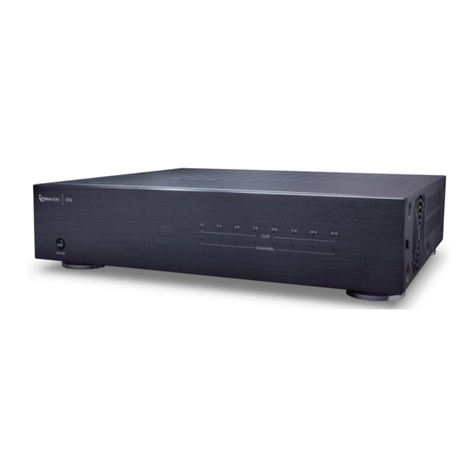
TRU Audio
TRU Audio D16 User manual
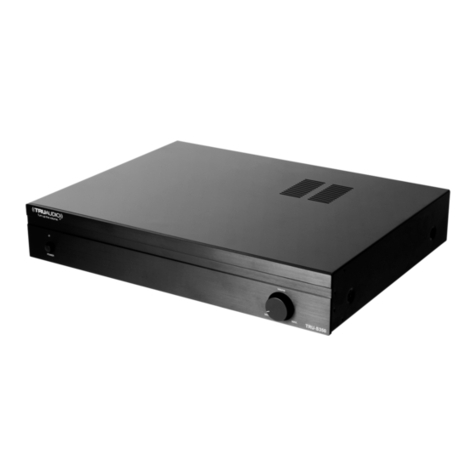
TRU Audio
TRU Audio TRU-S350xi User manual
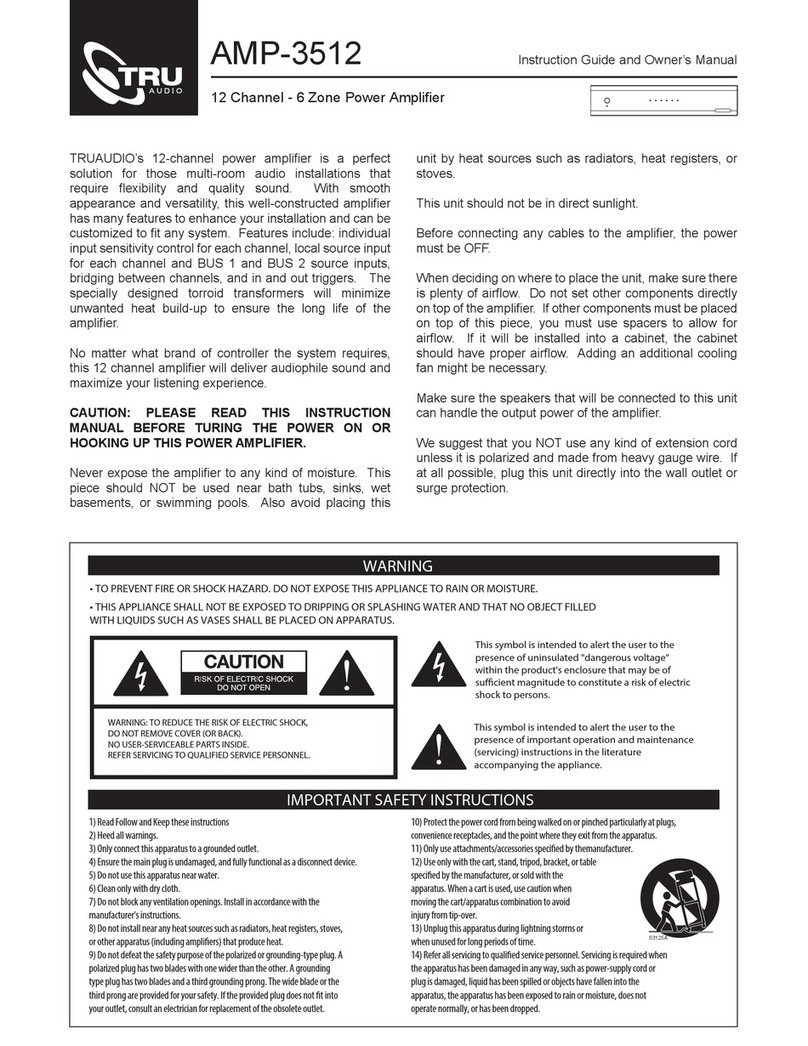
TRU Audio
TRU Audio AMP-3512 User manual
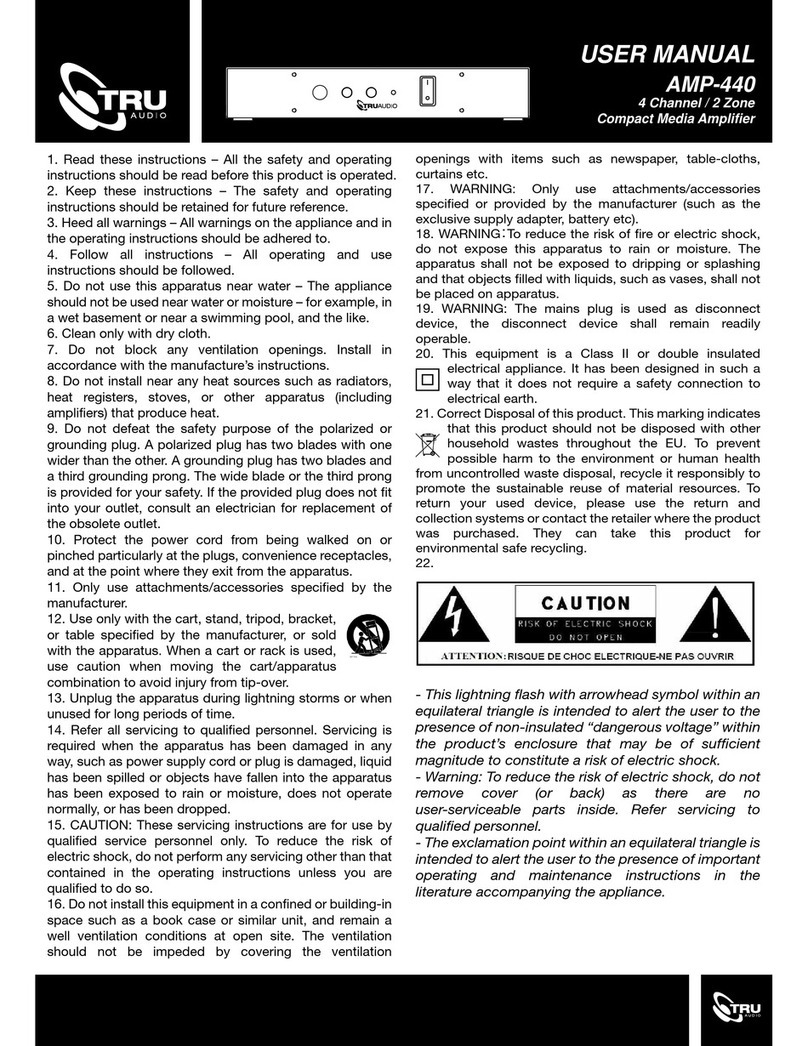
TRU Audio
TRU Audio AMP-440 User manual
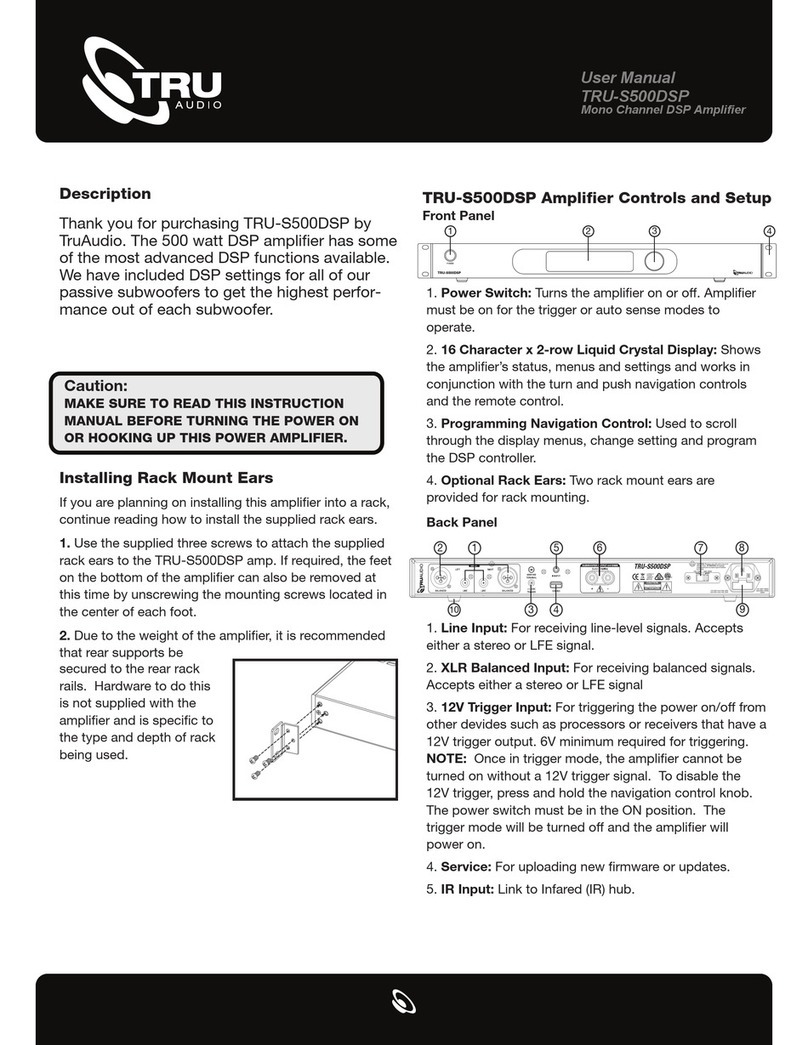
TRU Audio
TRU Audio S500DSP User manual
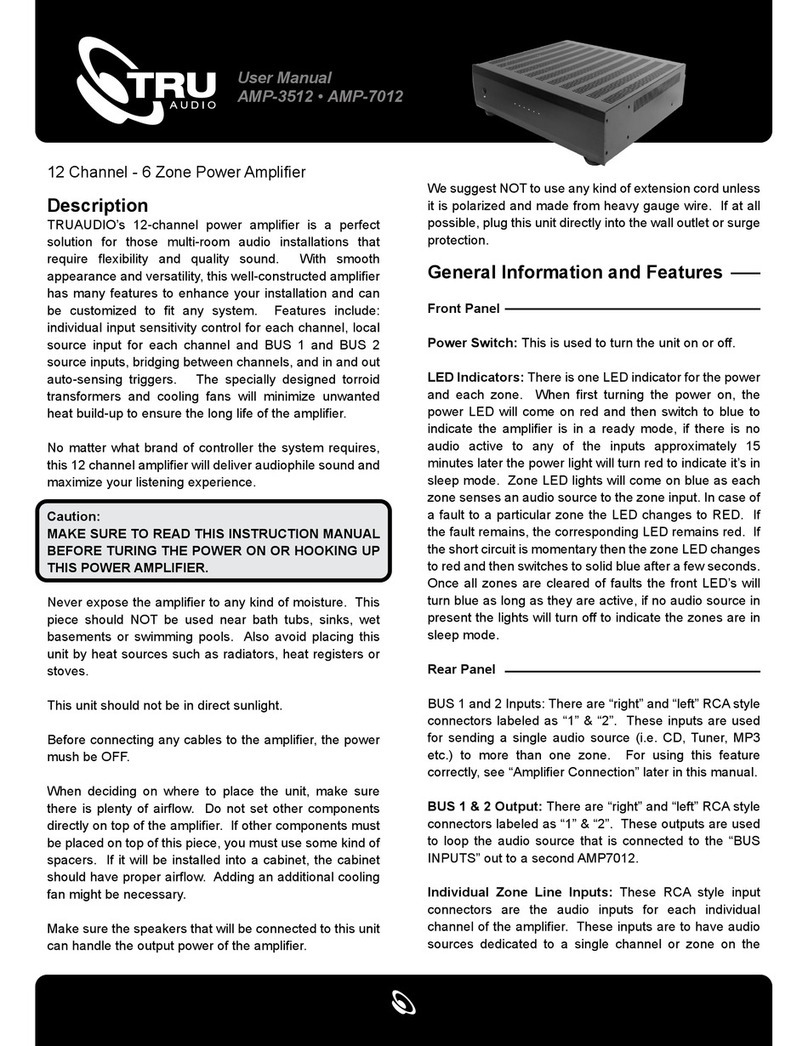
TRU Audio
TRU Audio AMP-3512 User manual
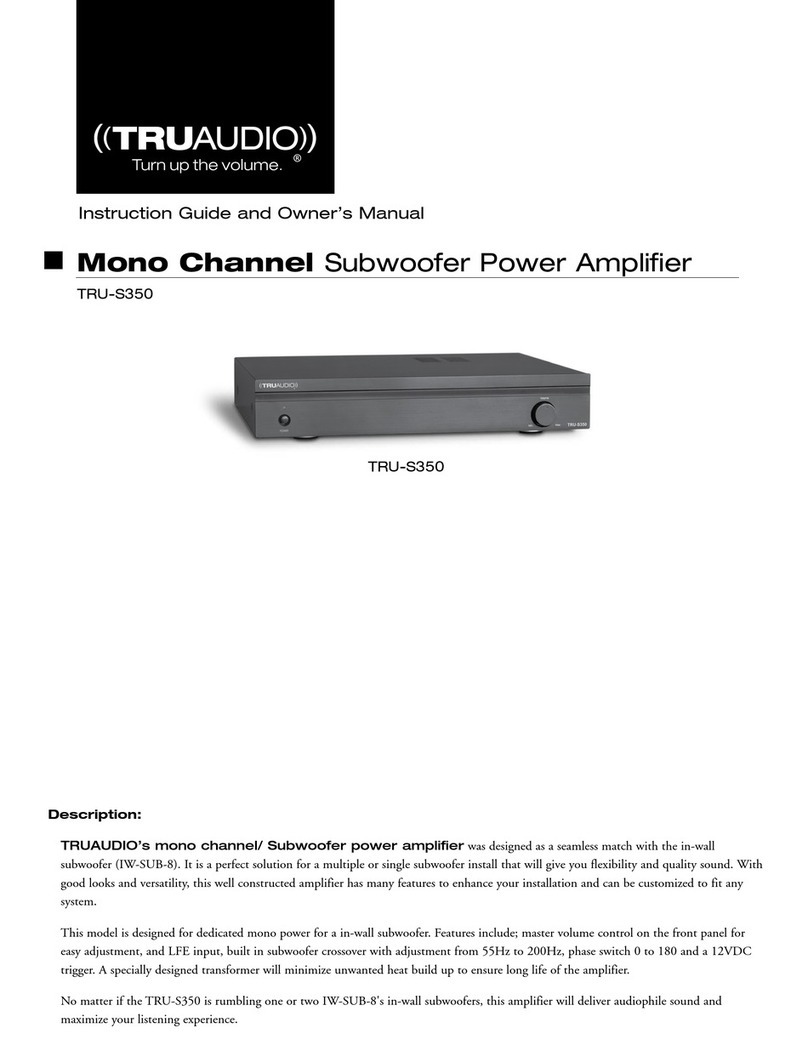
TRU Audio
TRU Audio TRU-S350 User manual

TRU Audio
TRU Audio T100 User manual
